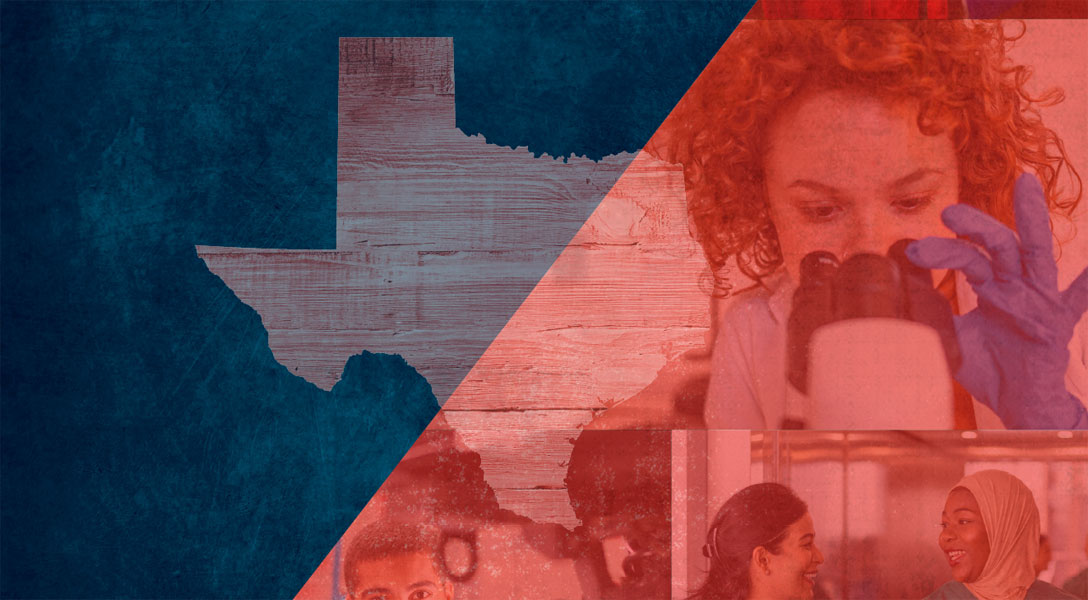
All Eyes on Texas: Community Colleges Focus on Preparing the Workforce of Tomorrow
Executive summary
The Texas economy is changing and, with it, the state’s need for education and training.
Many of the more than 4 million jobs the state expects to add in the next 15 years will require a bachelor’s degree or more. But there will also be continued need for what some call “middle-tier” workers—those with more than a high school diploma but less than a four-year college degree.
A significant share of the middle tier—especially technicians and skilled service employees—will be relatively well paid, with benefits and opportunities for promotion. In Texas, as nationwide, few institutions are better positioned to provide job-focused education and training for middle-tier workers than the state’s 54 community and technical colleges.
More than 40 percent of all Texans enrolled in higher education attend two-year public institutions. The state’s rapidly growing Hispanic population relies heavily on two-year schools, and a community college education remains relatively affordable. Average annual tuition: $2,828.
Unlike some states, which overlook community colleges and the essential role they can play preparing the workforce of tomorrow, Texas has focused recent policy initiatives on this often-untapped potential, looking for ways to realize it for the state.
Texans driving these reforms face a variety of challenges.

The state’s community colleges vary widely, from tiny schools serving remote rural areas to giant, urban institutions serving a broad range of learners, some living in well-to-do suburbs and others from disadvantaged inner cities. Some of the state’s two-year institutions are flush with funding; others just manage to keep their doors open.
In Texas, as in many states, community colleges struggle to balance two disparate missions: preparing some students for the workplace and others for future higher education. Reformers seeking to enhance workforce education inherit a system skewed toward academic preparation.
In Texas, as nationwide, community college graduation and transfer rates remain disappointing. And although underrepresented minority students are catching up on many metrics, they still trail non-Hispanic white students on other important measures, including transfer rates to four-year colleges and universities.
Meanwhile, in Texas, as nationwide, the age range of the students attending community college—always broader than the range at four-year institutions—is expanding dramatically, with dual-credit high school students and midcareer adults accounting for a growing share of the student body. Both groups bring new challenges and distinctive needs, particularly for workforce educators.
But Texas reformers seeking to elevate community college workforce education also build on an array of advantages.
The first advantage: a distinctive Texas education governance model. The state’s community college system is at once highly decentralized and coordinated by a central authority—an unusual federalist balance that lends itself to innovation at the campus level yet leaves room for guidance and support from the Texas Higher Education Coordinating Board (THECB).
The second advantage is well-developed employer engagement. A significant share of most Texas community colleges’ funding comes from local property taxes. Representatives of local companies often dominate individual institutions’ governing boards. As a result, many schools enjoy unusually close relationships with local employers, a key ingredient of effective workforce education.
The third advantage: Today’s reformers build on two decades of innovation. A handful of distinctive features, including funding mechanisms, now well-entrenched in Texas, are seen as models by educators nationwide.
At Texas State Technical College (TSTC), an outcomes-based funding formula rewards the institution on the basis of students’ postgraduation wages. A statewide common-course numbering system puts credit and noncredit workforce programs on a roughly equal footing, providing funding and a measure of quality control for short, agile, nondegree courses that can respond in real time to the changing needs of employers and job seekers. Also important and a potential foundation for future innovation: a Texas Workforce Commission grant program that creates incentives for intensive partnerships between community colleges and local companies with talent shortages.
Among the reform initiatives launched in recent years:
- Texas was one of the few states in the nation to use federal pandemic stimulus funding to provide support for out-of-work adults attending short, job-focused community college programs—a down payment on what may become a permanent, state-funded grant initiative.
- In fall 2021, the THECB amended the state’s higher education strategic plan to put new emphasis on racial and ethnic diversity, midcareer adults and nondegree credentials valued in the labor market.
- A community college finance commission appointed by the Legislature proposed in November 2022 a dramatic overhaul of the state’s college funding formula.
- In coming months, the THECB will unveil new public data dashboards to help educators, employers and students track attainment of credentials that pay off in the labor market.
The results of these changes may not be known for months or years to come, and much work remains. But together these initiatives put Texas on the front lines of a nationwide push to realize the potential of community colleges as the country’s premier provider of job-focused education and training. This winter and beyond, all eyes will be on Texas—a laboratory for the nation.
About the author
Acknowledgments
This report would not have been possible without the generous input of Texas educators and education officials—leadership and staff at the Texas Higher Education Coordinating Board and faculty and administrators at community and technical colleges across the state. Special thanks to those at Austin Community College, Dallas College and Texas State Technical College who took time for extra interviews explaining Texas community college funding and the innovation on their campuses. The author is indebted to University of Michigan School of Education associate professor Peter Riley Bahr and his research team, especially Rooney Columbus, for insights based on their important forthcoming study of noncredit education in Texas and four other states. Special gratitude to Federal Reserve Bank of Dallas economists Pia Orrenius and Jason Saving for their interest in community colleges and their constructive criticism of the paper.
“All Eyes on Texas: Community Colleges Focus on Preparing for the Workforce of Tomorrow” is a publication of the Research and Community Development departments of the Federal Reserve Bank of Dallas.
Articles may be reprinted on the condition that the source is credited and a copy is provided to the Research and Community Development departments.
The views expressed are those of the authors and should not be attributed to the Federal Reserve Bank of Dallas or the Federal Reserve System.
January 2023





